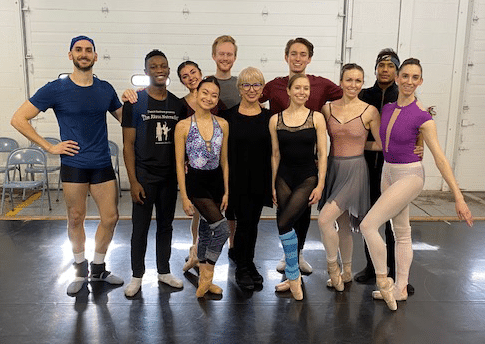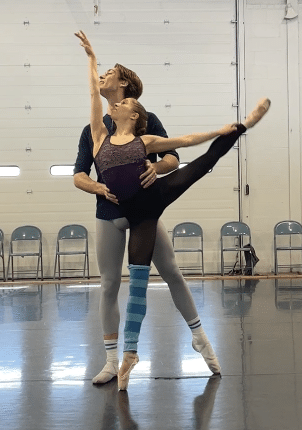
Verb Ballets is an action-oriented company that commissions and makes new dance works, preserves contemporary repertory, and builds community through performances and educational programs. Verb maintains its history of female leadership under the direction of Dr. Margaret Carlson and has sought to promote diversity among its dancers, staff, and board in terms of gender, race, ethnicity, sexual orientation, and country of origin. The company strives to commission new works while maintaining dance virtuosity and production excellence on par with the historic leading companies of the region.
Verb Ballets performs Arpino’s Celebration on a program taking place February 18 in Cleveland. Staging the work on the company is Cameron Basden, a répétiteur and board member for the Gerald Arpino Foundation. For information, visit verbballets.org/celebrations23/
Basden is the co-founder and artistic/executive director of Miami Dance Hub, created to unify the SoFlo dance commonwealth, grow audiences, promote dance, and provide resources for dance-related endeavors in South Florida. After a performing career with The Joffrey Ballet, she served as the company’s ballet master and co-associate director, then director of dance at Interlochen Center for the Arts. Basden was a muse for Gerald Arpino in the creation of his ballets and danced in a variety of styles by many noted choreographers. She oversaw the filming and staging of the ballets in Save the Last Dance and played herself in Robert Altman’s film The Company. Basden’s television credits include the PBS Dance in America series Billboards, Homage to Diaghilev, and The Search for the Rite of Spring. She serves on the advisory board for DanceNow! Miami and served on the Cultural Arts Committee for the World OutGames Miami 2017. She is the dance writer for miamiartzine and Artburst Miami.

Cameron Basden’s thoughts and reflections:
What is your personal history performing Arpino works?
In 1979, I was called off of a Joffrey II tour to join the main company in Houston, Texas. The company had just traveled to Mexico, and many dancers were unable to perform because of stomach issues, so they needed a dancer to step in—and that was me. The first ballet I ever danced as a member of the main company was Arpino’s ballet Suite Saint-Saëns. I did a different role every night of the week depending on who was out. So right off the bat, I had a big dose of Arpino’s choreography.
During my years dancing the Joffrey’s magnificent repertory, Arpino ballets always held a very special place in my heart. Not only were they fun and fulfilling to dance, I had a rather unique choreographer/dancer relationship with Arpino and spent many hours in the studio with him to workshop material that later became ballets—especially his ballets of the ’80s. He called our time together “playing,” though it could be four or five hours a day!
As a young dancer in New York, I felt it was such a privilege and honor to spend those hours with him. During that time, I learned to understand what Arpino wanted—his movement quality, the energy and fast footwork that he loved, the speed. He would create the movement, the vocabulary, and style, then our ballet master Scott Barnard would create patterns and musicality. It was such fun—and ballets such as Light Rain, Birthday Variations, Italian Suite, Celebration, and material used in other works were all workshopped there.
Dancing and seeing multiple casts perform the ballets gave me good insight into his ballets and the necessary movement quality. Being with Arpino, I learned to understand the various versions he created for different individual dancers, though I always go back to the original ballet when I’m staging it.
Now, I try to remember what he said to me when I worked with him, the motivation, the quality, to pass on that information to the next generation of dancers. I’ve worked with companies and universities all across the U.S. that are discovering his works, and I hear so often, “Why didn’t we do this ballet before?” I think the ballets are timeless and such an inspiration for both dancers and audiences.
What does it mean to you to work on Celebration for Verb Ballets as we celebrate Mr. Arpino’s centennial?
Of all the ballets we worked on together, Celebration holds a particularly special spot because it was the very first ballet I worked with Arpino on creating. I also had a wonderful partner, Glenn White. So to be working on this ballet with the lovely Verb dancers is quite a special experience.
The Joffrey last did Celebration in 2005 to open their 50th Anniversary Season in Chicago, and no company has done it since. So not only is Verb the first ballet company to perform Celebration outside of the Joffrey, but to “celebrate” the Arpino centennial with this ballet seems the most appropriate way to honor Arpino and celebrate Verb Ballets. Also, Celebration is very difficult, fast, and dynamic—and Verb is doing a wonderful job!

How would you describe the Arpino style? What are some distinctive elements of his choreography?
In the ’60s and ’70s you were either a ballet dancer or a modern dancer; dancers didn’t “do it all” the way they do today. Arpino, in a way, was ahead of his time. He loved classical ballet, the use of the feet and legs, clean, clear technique, extensions—but he also loved modern dance and the way the dancers used the floor, the twist of their backs, the way they ate space. In his choreography, Arpino blended the two. He wanted you to move with energy, to use the sides of the body and the back, and he liked fast footwork. His dancers could cover space; each step moved. He also liked your legs and arms really low or really high, a rather streamlined look. His partnering was difficult; the men had to be strong to make everything look effortless, lifting that covered space and leans and off balances.
As a choreographer, he would say you never left the stage—everything had to continue beyond the wings. His ballets ranged from the most classical to very contemporary and often were a comment on social issues of the time. He loved dancers flying across the stage at rocket speeds, and, by contrast, he would spend hours on the way a leg moved or where your focus was when you walked. He always said, in a duet, “if you don’t know where to look, look at each other.” One of his favorite words that anyone who worked with him knows is “Zah!”
How does dancing Arpino ballets prepare a dancer for other types of repertory?
At the Joffrey, we danced Arpino rep so often, we didn’t realize how integral it was to dancing in other ballets—the sense of movement, the partnering, the speed. Since becoming a répétiteur, I see how the dancers change after having worked on an Arpino ballet.
First and foremost, they’re usually sore from using the back and the side of the body in a more extreme way. Dancers learn to use the floor to move quickly and use space in each and every step. Running and using the legs to maximum capacity is a benefit we don’t realize happens—but it does. One other aspect is being true to the choreographer’s vision and making each ballet, Arpino or otherwise, look unique to itself. Arpino’s choreography has certain expectations that make it uniquely Arpino, as do most choreographers. I think we learned that at the Joffrey, and it’s a vital element of performance that keeps dancers and audiences invigorated and interested.
